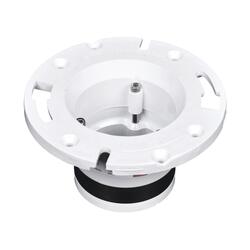Just about every person has their own individual idea in relation to Toilet Flange Repair.

Introduction:
Understanding the Importance of a Toilet Flange:
In the realm of plumbing, the often-overlooked toilet flange plays a critical role in making certain the smooth operation of your washroom components. Acting as a crucial adapter in between your commode and the underlying waste pipe, the commode flange acts as the unsung hero of your plumbing system. Without this tough component, your commode would certainly be prone to instability and leaks, possibly causing pricey repairs and inconvenience. For that reason, comprehending the significance of a properly set up and kept toilet flange is paramount for any kind of homeowner starting plumbing projects or addressing repair work needs.
Why Proper Installation and Maintenance Matter:
Proper installment and precise upkeep of the toilet flange are indispensable for guarding the honesty of your plumbing framework. A thoroughly installed flange not just supports your commode safely in place yet likewise creates a bulletproof seal, warding off the perils of leaks and smells. By accepting a proactive approach to flange upkeep, you can alleviate the danger of turbulent plumbing problems and maintain the tranquillity of your family setting. Throughout this insightful guide, we'll unravel the details of bathroom flange setup and repair, empowering you with the expertise and competence to browse these vital jobs expertly.
Best Practices When Installing a Toilet Flange:
Guaranteeing a smooth commode flange installment requires adherence to a set of ideal practices that ensure toughness and functionality. Begin by diligently analyzing your devices and products, guaranteeing you have the essential devices for the task in advance. Selecting the ideal flange material, whether PVC, ABS, or cast iron, is extremely important, as it determines the long life and performance of your plumbing fixture. In addition, examining existing plumbing conditions, such as checking for damages or deterioration, is important for preemptively attending to prospective problems and making sure a smooth installment process. By taking on these primary procedures, you established a strong structure for an effective commode flange installment, reducing the probability of future concerns and assisting in long-lasting maintenance.
Once adequately prepared, proceed with the cautious elimination of the old flange, complying with a methodical strategy to prevent causing damages to bordering parts. Utilize strategies tailored to deal with persistent or rusted flanges, ensuring their swift and risk-free removal without compromising the honesty of the surrounding plumbing infrastructure. With the old flange eliminated, carefully mount the brand-new substitute flange, picking one that fits snugly and firmly into location. Correctly securing the flange to the floor using screws or adhesive is critical, as it makes certain stability and avoids future leaks. By adhering to these best methods during the installation procedure, you prepared for a durable and dependable toilet flange configuration that holds up against the test of time.
Setting Up a New Toilet Flange:
When setting up a brand-new commode flange, the first step is to pick the appropriate replacement for your plumbing arrangement. Think about aspects such as the product of the flange, with options including PVC, ABS, or cast iron. PVC flanges are understood for their cost and resistance to corrosion, making them a preferred option for DIY lovers. ABS flanges use similar benefits to PVC yet brag included toughness, making them suitable for high-traffic areas or business settings. Cast iron flanges, renowned for their toughness and longevity, are suitable for installations where resilience is vital. Additionally, guarantee that the substitute flange is correctly sized and fits comfortably into place to create a watertight seal and avoid leakages.
Protecting the Flange to the Floor:
As soon as you've picked the right replacement flange, it's important to secure it properly to the floor to make certain stability and avoid future problems. Begin by placing and aligning the flange appropriately over the drain, ensuring that it sits flush with the flooring surface area. Relying on the kind of flange and your details setup choices, you can secure the flange to the flooring making use of screws or sticky. If making use of screws, make certain to utilize corrosion-resistant options to avoid rusting in time. Alternatively, adhesive can supply a safe bond in between the flange and the floor, ensuring a tough and trusted setup. By adhering to these steps and taking the essential precautions, you can set up a brand-new toilet flange with self-confidence, making certain a resilient and leak-free plumbing component.
Best Practices When Repairing a Broken Flange:
Repairing a damaged bathroom flange needs thorough attention to information and adherence to ideal techniques to make certain a lasting solution. Begin by thoroughly evaluating the extent of the damages and determining the underlying cause, whether it be deterioration, splits, or imbalance. This evaluation will lead your repair strategy, allowing you to pick the most proper methods and materials for restoring the flange to its optimal problem. Furthermore, think about the surrounding plumbing infrastructure and flooring stability to resolve any type of potential adding factors and stop future issues from occurring. By performing an extensive analysis and analysis, you lay the groundwork for an efficient and long-lasting repair service process that resolves the source of the trouble.
With a clear understanding of the flange's condition and the aspects affecting its damage, proceed with the repair work process utilizing accuracy and care. Depending upon the intensity of the damages, you may opt for repair approaches such as epoxy putty, fixing flange sets, or partial flange replacements. Ensure that the picked repair work approach effectively deals with the specific concerns at hand while maintaining the structural honesty and capability of the flange. Furthermore, take proactive actions to reinforce the repaired flange and stop future damages, such as applying sealer or waterproofing materials to safeguard versus leaks and rust. By sticking to these ideal practices throughout the repair process, you can restore your damaged flange to ideal condition, making sure the lasting integrity and performance of your plumbing system.
Types of Toilet Flanges:
Understanding the various sorts of commode flanges is important for selecting one of the most appropriate option for your plumbing requires. PVC, ABS, and cast iron are amongst the typical materials made use of in bathroom flange construction, each offering distinctive benefits and considerations. PVC flanges, known for their price and corrosion resistance, are favoured for their ease of installment and resilience. Abdominal muscle flanges, similar to PVC in terms of cost and simplicity of installation, are valued for their effectiveness and resistance to impacts. On the other hand, cast iron flanges, renowned for their phenomenal stamina and durability, are commonly liked for high-traffic locations or business settings where longevity is extremely important. By acquainting on your own with the characteristics of each material, you can make an informed decision when selecting a commode flange that lines up with your certain requirements and preferences.
In addition to material factors to consider, commode flanges additionally come in various design and styles to suit different plumbing configurations and installment choices. Offset flanges, for example, are made to fit bathrooms mounted on floorings that are not level or where the waste pipe lies off-centre. Likewise, repair service flanges, additionally referred to as fixing rings or spacer rings, are utilized to deal with problems such as broken or broken flanges without the requirement for substantial plumbing alterations. Furthermore, adjustable flanges provide versatility in positioning, enabling exact positioning and fit throughout installment. By exploring the diverse variety of bathroom flange types and layouts available, you can select the alternative that ideal fits your plumbing arrangement and installment requirements, guaranteeing a smooth and reliable service for your restroom fixtures.
Specialty Options:
In addition to standard toilet flanges, there are specialized choices offered to deal with specific plumbing difficulties and installment preferences. One such alternative is the balanced out flange, which is created to fit toilets installed on floorings that are not level or where the waste pipe lies off-centre. Balanced out flanges feature a distinct style that permits the toilet to be positioned at a minor angle, making up for irregular flooring or misaligned plumbing links. This innovative option ensures a secure and secure installment, getting rid of the demand for costly and time-consuming flooring leveling or pipeline relocation. By including a balanced out flange right into your plumbing configuration, you can overcome usual installation barriers and accomplish a professional-quality outcome with ease.
An additional specialty alternative worth thinking about is the fixing flange, also referred to as a fixing ring or spacer ring. Repair flanges are especially made to deal with concerns such as broken or broken bathroom flanges without the requirement for considerable plumbing adjustments. These versatile elements can be set up straight over the existing flange, giving a sturdy and reliable base for securing the bathroom in position. Repair flanges come in numerous dimensions and configurations to accommodate various flange sizes and installation requirements, making them a practical and economical service for fixing flange-related problems. Whether you're managing a minor flange repair or an extra intricate plumbing problem, integrating specialty options like countered and repair flanges can simplify the setup process and make certain durable performance for your restroom components.
Final thought:
To conclude, grasping the art of toilet flange installment and repair work is crucial for maintaining a functional and leak-free plumbing system in your house. By recognizing the importance of a correctly installed flange and sticking to best practices throughout the process, you can guarantee the longevity and reliability of your restroom components. Whether you're picking the best kind of flange, carrying out fixings, or checking out specialty choices, interest to information and meticulous implementation are crucial. Normal upkeep and aggressive troubleshooting can aid prevent pricey plumbing issues and preserve the harmony of your house setting. Equipped with the knowledge and skills obtained from this extensive overview, you can deal with commode flange setup and repair service with confidence, empowering you to guard your plumbing system for many years to come.
How to Replace a Toilet Flange
The toilet flange is the part that keeps your toilet attached to the drain. A broken toilet flange will result in your toilet moving around and can even cause it to leak.
A broken toilet can be such a headache and the leaking water can even cause further damage. Many people don’t know about the different elements of replacing a toilet or fitting a new toilet, and it’s important to know these skills when you’re a homeowner.
This article will walk you through how to quickly and correctly do a toilet flange repair.
How to Replace a Toilet Flange
A toilet flange is a critical element of a toilet, but it serves two separate functions. For instance, a toilet flange secures your toilet unit onto the ground and connects the toilet bowl to the wastewater line.
Often, a toilet flange is already in place when installing a toilet, so many homes have these features but never think of them until they are broken. Therefore, you need to know when to replace a toilet flange.
Remove the Toilet
The first stage is removing the toilet and disconnecting the structure from the water supply. You can close the knob at the back of the toilet and empty the toilet tank several times.
After this, you should remove the water hose from the toilet. It’s essential to cover your bathroom floor with newspaper or a tarp to ensure there’s no external damage to your space.
This can be a complicated process, so getting professional help may be necessary if you don’t feel confident about replacing a toilet flange. When you work with an experienced professional, you can ensure the job is done correctly.
Unscrew Two Nuts and Bolts
The two nuts and bolts are the parts that hold the toilet to the flange and floor, so you need to tackle this part next. You can use an adjustable wrench if the nuts are secure and too tight.
After this, you can set the nuts aside in a container and reattach the toilet when the flange is completely repaired.
Remove the Old Wax
Next, after you’ve removed the toilet and nuts and bolts features, you should remove the old wax that sealed the toilet to the flange. You can quickly eliminate the old wax with a putty knife or other similar tool.
Work your way down the build-up of old wax until you reach the top of the toilet flange.
Remove the Flange
Once you reach the flange structure, you can search for the screws outside the part. All you need to remove the screws is a multi-head screwdriver, allowing you to remove different screws.
You can remove the flange and clean it with disinfectant or a wipe to sanitize the surface area. It’s also a good idea to stuff an old towel or cloth into the space to prevent odors and gasses from oozing from the area.
This is where you need to measure the diameter of the outflow pipe’s mouth to find the identical part to replace the toilet flange. You must have exact measurements when searching for a new flange.
Otherwise, you will buy a new toilet flange that can be used in your bathroom.
You can also take the old toilet flange in a secure bag to your local hardware shop if you want to make a direct comparison with a new product. You must also buy sealing wax for the new toilet flange.
If you need help buying a new toilet flange, a professional plumber can help or an employee at your local store.
Apply New Flange and Fit Toilet
At this point, you can fit the new toilet flange following the instructions given with the product, or you can hire a professional to do the job for you. You should also apply the new seal wax around the mouth.
This will allow the toilet flange to stay in place and not become broken again shortly.
Finally, you can fit the toilet structure back in place by securing the nuts and bolts again. You should reattach the water supply and test the flush to check that the water is running correctly.
To test the water supply, you can flush the toilet several times and wait for the water to fill up and empty repeatedly.
The last step is to tidy the bathroom space and clear away the dirty towels or newspapers. It’s a good idea to clean the floors with a strong disinfectant to eliminate the odors left behind.
With experience, you can fix the toilet flange in no time. But, if you’ve never handled these toilet parts, you should hire a professional plumber to take care of them.
Thankfully, our team is here for you. We have the best plumbers in Detroit to help you fix any toilet issues you encounter at home.
https://waterworkplumbing.com/how-to-replace-a-toilet-flange/

I discovered that blog post on How to Replace a Toilet Flange while doing a lookup on the internet. Enjoyed reading our blog? Please share it. Let others locate it. We value your readership.
Visit
 Emilio Estevez Then & Now!
Emilio Estevez Then & Now! Jenna Jameson Then & Now!
Jenna Jameson Then & Now! Erik von Detten Then & Now!
Erik von Detten Then & Now! Burke Ramsey Then & Now!
Burke Ramsey Then & Now! Samantha Fox Then & Now!
Samantha Fox Then & Now!